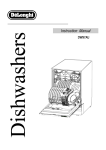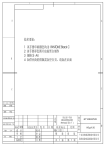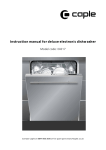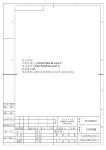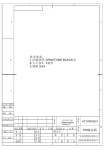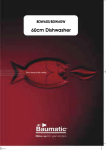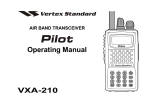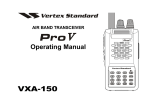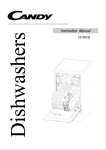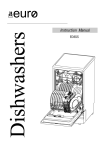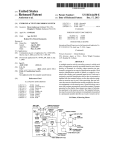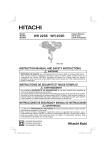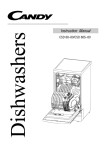Download Elba EBDW 9235-M SS Technical information
Transcript
EBDW 9235-M SS EBDW 9235-M W Dear Costumer, Please r ead this User Information carefully and keep it to refer to at a later date. Pass it on to any subsequent owner of the appliance. This manual contains sections of Safety Instructions, Operatin g Instructions, Installation Instructions and Troubleshooting Tips etc. Carefully reading it before using the dishwasher will help you to use and maintain the dishwasher properly. Control Panel......................................................3 Dishwasher Features............................................3 Water Softener....................................................5 Rinse Aid.........................................................5, 6 Detergent........................................................7, 8 How to use the 3 in 1 program ..............................9 Not suitable for the dishwasher............................12 At the end of the wash cycle ................................13 Wash Cycle Table...............................................14 Setting the programme.......................................15 Forget to add a Dish................. ........ ...................16 Filtering System..................................................17 Caring for the Dishwasher..............................17, 18 To review the section on Troubleshooting Tips will help you to solve some common problems by yourself and not need to ask for the help of professional technicians. Water Connection...............................................19 Connection of drain hoses...........................................20 Start of dishwasher ............................................ 20 Before calling for service...............................21, 22 Error codes.......................................................22 The manufacturer, following a policy of constant development and up-dating of the product, may make modifications without giving prior notice. Technical information ....................................... 23 Under certain conditions, Hydrogen gas may be produced in a hot-water system that has not been used for two weeks or more. HYDROGEN GAS IS EXPLOSIVE.If the hot-water system has not been used for such a period, before using the dishwasher turn on all hot-water faucets and let the water flow from each for several minutes. This will release any accumulated hydrogen gas. As the gas is flammable, do not smoke or use an open flame during this time. · Do not abuse, sit on, or stand on the door or dish rack of the dishwasher · Do not touch the heating element during or immediately after use · Do not operate your dishwasher unless all enclosure panels are properly in place. Open the door very carefully if the dishwasher is operating. There is a risk of water squirting out. · Do not place any heavy objects of stand on the door when it is open. The appliance could tip forward. · When loading items to be washed: o Locate sharp items so that they are not likely to damage the door seal; o Load sharp knives with the handles up to reduce the risk of cut-type injuries; o Warning: knives and other utensils with sharp points must be loaded in the basket with their points down or placed in a horizontal position. · When using your dishwasher, you should prevent plastic items from contacting with heating element. · Check that the detergent receptacle is empty after completion of the wash cycle. · Do not wash plastic items unless they are marked dishwasher safe or the equivalent. For plastic items not so marked, check the manufacturer's recommendations. · Use only detergent and rinse additives designed for an automatic dishwasher. Never use soap, laundry detergent, or hand washing detergent in your dishwasher. · Other means for disconnection from the supply must be incorporated in the fixed wiring with at least 3mm contact separation in all poles. · Keep children away from detergent and rinse aid, keep children away from the open door of the dishwash er, there could still be some detergent left inside. · Young children should be supervised to ensure that they do not play with the appliance. · The appliance is not intended for use by young children or infirm persons without supervision. · Dishwasher detergents are strongly alkaline. They can be extremely dangerous if swallowed. Avoid contact with skin and eyes and keep children away from the dishwasher when the door is open. · The door should not be left in the open position since this could present a tripping hazard. · If the supply cord is damaged, it must be replaced by the manufacturer or its service agent or a similarly qualifi ed person in order to avoid a hazard. · Please dispose of packing materials properly. · Use the dishwasher only for its intended function. · During installation, the power suppl y must not be excessively or dangerously bent or flattened. · Do not tamper with controls. · The appliance is to be connected to the water mains using new hose sets and the old hose-sets should not be reused. 1 Dispose of the dishwasher packaging material correctly. All packaging materials can be recycled. Plastic parts are marked with the standard international abbreviations: ØPE for polyethylene, e.g. sheet wrapping material ØPS ØPOM ØPP ØABS for polystyrene, e.g. padding material polyoxymethylene, e.g. plastic clips polypropylene, e.g. Salt filler Acrylonitrile Butadiene Styrene, e.g. Control Panel . Warning! Packaging material could be dangerous for children! For disposing of package and the appliance please go to a recycling centre. Therefore cut off the power supply cable and make the door closing device unusable. Cardboard packaging is manufactured from recycled paper and should be dis posed in the waste paper collection for recycling. By ensuring this product is disposed of correctly, you will help prevent potential negative consequences for the environment and human health, which could otherwise be caused by inappropriate waste handling of this product. For more detailed information about recycling of this product, please contact your local city office and your household waste disposal service. 2 To get the best performance from your dishwasher,read all operating instructions before using it for the first time. ON O FF Pr og. Star t Reset 4 2 3 5 6 ON/OFF Button: To turn on/off the power supply. 4 Display Window: Program remaining time, delay time, running indicator, faut codes and etc. 2 Power on light: To come on when Power ON/OFF button is pressed down. 5 Program Key-press:To select washing program when press the Key-press. 3 Delayed Start Button: Press this button to set the delayed hours for washing. You can delay the start of washing up to 24 hours. One press on this button delays the start of washing by one hour. 6 Start / Reset Button: Press this button to start or pause the dishwasher, the one of six program lights will blink when starting. Back View Front view 7 1 2 3 8 4 5 9 6 11 10 12 13 1 2 3 4 Upper Basket Spray Arms Lower Basket Water Softener 5 6 7 8 Main Filter Detergent Dispenser Cup Shelf Silverware Basket 3 9 Coarse Filter 10 Rinse Aid Dispenser 11 Drain pipe connector 12 Inlet pipe connector 13 Tray ass. Before usi ng your dishwasher for the first time: A. B. C. D. Set the water softener Pour 1/2 litre of water inside the salt container and then fill with dishwasher salt Fill the rinse aid dispenser Function of detergent The water softener must be set manually, using the water hardness dial . The water softener is designed to remove minerals and salts from the water, which would have a detrimental or adverse effect on the operation of the appliance. The hi gher the content of these minerals and salts, the harder your water is. The softener should be adjusted according to the hardness of the water in your area. Your local Water Authority can advise you on the hardness of the water in your area. Adjusting Salt Consumption The dishwasher is designed to allow for adjusting the amount of salt consumed based on the hardness of the water used. This is intended to optimize and customize the level of salt consumpti on so that the salt consumption could be set proceed as follows: 1. Unscrew the cap from the salt container 2. There is aring on the container w ith anarrow on it (see figure to theside), if necessary, rotate the ring in the anticlockwise direction from the “-”Setting toward the “+ ”sign, based on the hardness of the water being used. It i s recommended that adjustments should be made in accordance with the following schema: WATER HARDNESS dH fH 0~8 0~14 Clark 0~10 Selector Position Salt consumption (gram/cycle) Auto nomy (cycles/1.2kgs) 0~1.4 / 0 / - mmol/l 8~22 14~39 10~28 1.4~3.9 20 60 22~45 39~80 28~56 3.9~8 Mid 40 30 >45 >80 >56 >8 + 60 20 Note:1 ° dH=1.25 ° Clark=1.78 ° fH=0.178mmol/l ° dH : German degree ° fH : French degree ° Clark: British degree Contact your local water board for information on the hardness of your water supply. 4 Always use salt intended for use with dishwasher. The sal t container is locat ed beneath the lower rack and should be filled as foll ows: Atte ntion! Only use salt specifically designed for use in dishwa shers! All other t ypes of salt not spe ci fically designed for use in a dishwasher, e specially table salt, will damage the water softener. In case of dam ages caused by the use of unsui table salt the m anuf acturer does not give any warranty nor is liable for a ny cause d damages. Only fill with salt just before starting one of the complet e washi ng programmes. This wi ll prevent a ny grains of salt or salty wa ter, which may have been spli t, rem ai ning of the bottom of the machi ne for a ny period of tim e, which ma y ca use corrosion. Afte r the first wash cycle the control panel light expires. A Remove the lower basket and then unscrew and remove the cap from the salt container. B If you are filling the container for the first time, fill 2/3 of its volume with water (around 500ml). C Place the end of the funnel (supplied) into the hole and introduce about 1,2kg of salt. It is Normal for a small amount of water to come out of the salt container. D Carefully screw the cap back on. E Usually, the salt warning light will be off in 2-6 days after the salt container be filled with salt. NOTE: 1. The salt container must be refilled when the salt warning light in the control panel comes on. Though the salt container is filled enough, the indicator light may not black out before the salt fully dissolve. If there is no salt warning light in the control panel (for some models) , you can judge when to load the salt into the softener by the cycles that the dishwasher had run (see the following schema ). 2. If there are spills of the salt, a soak program could be run to wipe them out. Rinse aid is automatically added during the last rinse, ensuring thorough rinsing, and spot and streak free drying. Only use branded rinse aid for dishwasher. Never fill the rinse aid dispenser with any other substances (e.g. dishwasher cleaning agent, liquid detergent). This would damage the appliance. 5 If there is no rinse-aid w arning light in the control panel, you can judge the amount of rinse-aid by the color of the optical level indicator "D" located next to the cap. When the rinse-aid container is full, the whole indicator will be dark .As the rinse-aid diminishes, the size of the dark dot decreases. You should never let the rinse aid get below 1 / 4 full. D (Rinse-Aid indicator) As the rinse aid diminishes, the size of the black dot on the rinse aid level indicator changes, as illustrated below. Full 3 / 4 full 1 / 2 full 1 / 4 full - Should refill to eliminate spotting Empty 1 2 3 To open the dispenser, turn the cap to the "open" (left) arrow and lift it out. Pour the rinse aid into the dispenser, being careful not to overfill. Replace the cap by inserting it aligned with "open" arrow and turning it to the closed (right) arrow. The rinse aid is released during the final rinse to prevent water from forming droplets on your dishes that can leave spots and streaks. It also improves drying by allowing water to sheet off the dishes. Your dishwashers are designed to use liquid rinse aids. The rinse aid dispenser is located inside the door next to the detergent dispenser. To fill the dispenser, open the cap and pour the rinse aid into the dispenser until the level indicator turns completely black. The volume of the rinse aid container is about 140ml. Be careful not to overfill the dispenser, because this could cause over sudsing. Wipe away any spills with a damp cloth. Don't forget to replace the cap before you close dishwasher door. Attention! Clean up any rinse aid split during filling with an absorbent cloth to avoid excess foaming during the next wash. Adjust lever (Rinse) The rinse aid dispenser has six or four settings. Always start with the dispenser set on “2”. If spots and poor drying are problems, increase the amount of rinse aid dispensed by removing the dispenser lid and rotating the dial to “3”. If the dishes still are not drying properly or are spotted, adjust the dial to the next higher number until your dishes are spot-free. We suggest you to set on “4”(Factory value is “4”) NOTE: Increase the dose if there are drops of water or lime spots on the dishes after washing. Reduce it if there are sticky whitish streaks on the dishes or a bluish film on glassware or knife blades. 6 Detergents with its chemical ingredients are necessary to remove dirt, crush dirt and transport it out of the dishwasher. Most of commercial quality detergents are suitable for this purpose. Concentrated Detergent Based on their chemical composition, dishwasher can be split in two basic types: conventional, alkaline detergents wi th caustic components low alkaline concentrated detergents with natural enzymes The use of “normal” washing programmes in conjunction with concentrated detergents reduces pollution and is good for your dishes; these wash programmes are specially matched to the dirt-dissolving properties of the enzymes of the concentrated detergent. For this reason “normal”wash programmes in which concentrated detergents are used can ac hieve the same results that can otherwise only be achieved usi ng “intensive” programmes. Detergent Tablets Detergent tablets of different brands dissolve at different speeds. For this reason some detergent tablets cannot dissolve and develop their full cleaning power during short programmes. Therefore please use long programmes when using detergent tablets, to unsure the complete removal of detergent residuals. Detergent Dispenser The dispenser must be refilled before the start of each wash cycle following the instructions provided in the Wash Cycle Table? Your dishwashers use less detergent and rinse aid then conventional dishwashers. Generally, only one tablespoon of detergent is needed for a normal wash load. Also, more heavily soiled items need more detergent. Always add the detergent just before starting dishwasher, otherwise it could get damp and will not di ssolve properly. Amount of Detergent to Use 1 2 If the lid is closed: press release button. The lid springs open. Always add the detergent just before starting each wash cycle. Only use branded detergent aid for dishwasher. Dishwasher detergent is corrosive! Take care to keep it out of reach of children. Proper Use of Detergent Use only detergent specifically made for use in dishwashers. Keep your detergent fresh and dry. Don't put powder detergent into the dispenser until you're ready to wash dishes. 7 Fill in detergent 1 Fill the detergent dispenser with detergent. The marki ng indicates the dosing levels , as illustrated on right: 1 The place of main wash cycle detergent placed , “MIN”means approximately 20g of detergen. 2 The place of pre-wash cycle detergent placed , approximately 5g of detergent Please observe the manufacturers dosing and storage recommendations as stated on the detergent packaging. Close the lid and press until it locks in place. If the dishes are heavily soiled, place an additional detergent dose in the pre-wash detergent chamber. This detergent will take effect during the pre-wash phase. NOTE: You find information about the amount of detergent for the single programm es on the last page. Please aware, that according to the level soiling and the specific hardness of water differences are possible. Please observe the manufacturer's recommendations on the detergent packaging. Detergents There are 3 sorts of detergents 1.With phosphate and with chlorine 2.With phosphate and without chlorine 3.Without phosphate and without chloride Normally new pulverised detergent is without phosphate. The water softener function of phosphate is not given. In this case we recommend to fill salt in the salt container even when the hardness of water is only 6 dH. If detergents without phosphate were used in case of hard water often white spots appear at dishes and glasses. In this case please add more detergent to reach better results. Detergents without chlorine do only bleach a little. Strong and coloured spots will not removed completely. In this case please choose a programme with higher temperature. 8 2 Your dishwasher has a 3 in 1 program which needs not salt and rinse aid but a 3 In1 tablet. And this dishwasher comes with a 3 in 1 tablet container as an accessory. NOTE: Only 3 in 1 program uses 3 in 1 tablet. If using 3 in 1 tablet in other programs, the appliance will not get a best performance. 1、Referring to the below sketch map, hang the 3 in 1 tablet container on the upper basket. 2、Referring to the below sketch map, r otate the upper sprayer and change the location of the container if need to make sure the upper sprayer does not be cumbered by the 3 in 1 tablet container. 3、Put the 3 in 1 tablet into the container then start the 3 in 1 program. NOTE: When use “3 in 1 Combination / Compact DeterGents ,please pay attention to make sure that the size of the Combination Detergents is fitted to the dispenser ,so that Combination Detergents can be ease to put in the dispenser ,and dispenser would not be broken. Attention Keep all detergents in a safe place out of children's reach. Always add the detergent i n the dispenser just before starting the dishwas her. 9 For best performance of the dishwasher, follow these loading guidelines. Features and appearance of racks and silverware baskets may vary from your model. Attention before or after Loading the Dishwasher Racks Scrape off any large amounts of leftover food. It is not necessary to rinse the dishes under running water. Place objects in the dishwasher in following way: 1.Items such as cups, glasses, pots/pans, etc. are stood upside down. 2.Curve items, or those with recesses, should be at a slant so that water can run off. 3.They are stacked securely and can not tip over. 4.They do not prevent the spray arms from rotating while washing takes place. Very small items should not be washed in the dishwasher as they could easily fall out of the racks. Removing the Dishes To prevent water dripping from the upper back into the lower back, we recommend that you empty the lower basket first and then the upper back. Loading the Upper Rack The upper rack is designed to hold more delicate and lighter dishware such as glasses, coffee and tea cup and saucers, as well as plates, small bowls and shallow pans (as long as they are not too dirty). Position the dishes and cookware so that they do not get moved by the spray of water. 4 4 4 1 3 5 1 2 3 4 5 6 7 1 7 2 1 5 6 Adjusting the Upper Rack Cups Small serving bowl Large serving bowl Glasses Saucers Dish Dessert dishes If required, the height of the upper rack can be adjusted in order to create m ore space for large utensils either in the upper rack or lower rack. The upper rack can be adjusted for height by putting wheels of different height into the rails. Long items, serving cutlery, salad servers or knives should be placed on the shelf so that they do not obstruct the rotation of the spray arms. The shelf can be folded back or removed when not required for use. 10 We recommend that you place large items which are most difficult to clean in to the low er rack: pots, pans, lids, serving dishes and bowls, as shown in the figure to the right. It is preferable to place serving dishes and lids on the side of the racks in order to avoi d blocking the rotation of the top spray arm. Pots, serving bowls, etc. must always be placed top down. Deep pots should be slanted to allow w ater to flow out. The bottom rack feature fold down tine row s so that larger or more pots and pans can be loaded. 4 7 9 10 8 9 10 11 8 10 11 7 To improve stacking of pots and pans, the spikes can be folded down 11 Dessert dishes Oval platter Dinner plates Soup plates Silverware basket Silverware Basket Silverware should be placed in the silverware basket with handles at the bottom: If the rack has side baskets, the spoon should be loaded individually into the appropriate slots, especially long utensils should be placed in the horizontal position at th e front of the upper rack. 4 4 1 4 1 4 1 4 1 4 1 4 1 4 1 4 1 4 1 4 1 4 1 4 1 5 3 5 5 3 5 3 5 5 3 3 2 2 3 2 1 2 3 4 3 2 2 3 2 3 2 2 3 2 5 3 5 5 3 5 7 8 2 5 2 5 6 6 2 Forks Soup spoons Dessert spoons Teaspoons 5 6 7 8 Knife Serving spoon Gravy ladle Serving fork Do not let any item extend through bottom. For washi ng in the dishwasher the following cutlery/dishes Are of limited suitability Are not suitable Cutlery with wooden, horn china or mother-of-pearl handles Plastic items that are not heat resistant Older cutlery with glued parts that is not temperature resistant Bonded cutlery items or dishes Pewter or cooper items Lead crystal glass Steel items subject to rusting Wooden platters Items made from synthetic fibres Some types of glasses can become dull after a large number of washes Silver and aluminium parts have a tendency to discolour during washing Glazed patterns may fade if machine washed frequently NOTE: Do not put in items that are dirty of cigarette ash, candle wax, lacquer or paint. If you buy new dishes please make sure that they are suitable for dishwashers. NOTE: Please do not overload your dishwasher. There is only space for 8 standard dishes. Do not use dish that is not suitable for dishwashers. This is important for good results and for reasonable energy consume. Loading cutlery and dishes Before loading the dishes, you should: Remove large left-over Soften remnants of burnt food in pans When loading the dishes and cutlery, please note: Dishes and cutlery must not impede the rotation of the spray arms Load hollow items such as cups, glasses, pans etc. with the opening downwards so that water cannot collect in the container or a deep base 12 Di shes and items of cutlery must not lie inside one another, or cover each othe r To avoid damage to glasses, they must not touch Load large items which are most difficult to clean into the lower rack The upper rack is designed to hold more delicate and lighter dishware such as glasses, coffee and tea cups Attention! Long bladed knives stored in an upri ght position are a potential hazard! Long and/or sharp items of cutl ery such as carving knives must be positioned horizontally in the upper basket. Damage to glassware and other dishes Possible causes: Type of glass or manufacturing process. Chemical composition of detergent. Water temperature and duration of dishwasher programme. Suggested remedy: Use glassware or porcelain dishes that have been marked di shwasher-proof by the manufacturer Use a mild detergent that is described as kind of dishes If necessary, seek further information from detergent manufacturers. Select a programme with as low a temperature. To prevent damage, take glass and cutlery out of the di shwasher as soon as possible after the programme has ended. At the End of the Wash Cycle When the working cycle has finished, the buzzer of dishwasher will mooing 8 seconds, then stop. Turn of the appliance using the ON/OFF button, shut off the water supply and open the door of the dishwasher. Wait a few minutes before unloading the dishwasher to avoid handling the dishes and utensils while they are still hot and more susceptible to breakage. They will also dry better. 13 Pre-wash pre-wash wash45 rinse/ rinse68℃ drying For normally soiled loads, such as pots , plates,glasses and lightly soiled pans. standard daily cycle. 3in1 170 17.2 161 17 155 17 102 13.4 85 9.9 Strong For the heaviest soiled loads, such as pots,pans,casserole dishes and dishes that have been sitting with dried food on them for a while. Pre-wash Pre -wash( 5 0℃) Wash (60 ℃) Rinse Rinse (70 ℃) Drying 5/25 g. Normal For normally soiled loads, such as pots , plates,glasses and lightly soiled pans. standard daily cycle. Pre-wash Pre-wash Wash (50 ℃) Rinse Rinse (70 ℃) Drying 5/25 g. Economy For lightly soiled loads,such as plates,glasses,bowls and lightly soiled pans. Pre-wash Wash (45 ℃) Rinse Rinse (60 ℃) Drying 25 g. Rinse For dishes that need to be rinsed and dried only. Wash(45℃) Rinse Rinse (70 ℃) Drying (IEC-EN 50242) For lightly soiled loads, such as glasses, crystal and fine china. Rapid A shorter wash for lightly soiled loads that do not need drying. 14 Pre-wash wash(40℃) rinse rinse(70 ℃) drying 20 g. 108 13.4 Wash (40 ℃) Rinse Rinse 20 g. 29 8.9 Turning on the Appliance Starting a wash cycle... 1 Draw out the lower and upper basket, load the dishes and push them back. It is commended that loading the lower basket first, than the upper one (see the section entitled “Loading the Dishwasher”). 2 Pour in the detergent (see the section entitled “Salt, Detergent and Rinse Aid”). 3 Insert the plug into the socket. The power supply is 220-240 VAC 50 HZ, the specification of the socket is 12 A 250 VAC. Make sure that the water supply is turned on to full pressure. 4 With a little force to ensure the door is properly closed. NOTE: A click could be heard when the door is closed perfectly. 5 Cl ose the door,press the ON/OFFbutton,and the ON/OFF light will turn on. Press the "prog. "Button to select a desired "Wash cycle".(see the section entitl ed."Wash Cycle Table".) P ress the start/reset button to starting the program. 6 When the washing is over, you can shut off the switch by pressing ON/OFF button. ON OF F Pr og . St ar t R eset Premise: A cycle that is underway can only be modified if it has only been running for a short time. Otherwise, the detergent may have already been released, and the appliance may have already drained the wash water. If this is the case, the detergent dispenser must be refilled (see the section entitled " Loading the Detergent " ). Press the start/reset button, then press current prog. button more than three seconds to cancel the program , you can change the program to the desired cycle setting (see the section entitled " Starting a w ash cycle. . . " ). NOTE: If you open the door when washing, the machine will pause. When you close the door , the machine will keep on working after 10 seconds. If you open the door , the machine will pause. And the machine will then continue to run only if you press after closing the door. 15 A forgotten dish can be added any time before the detergent cup opens. 1 2 Open the door a little to stop the washing. 3 Add forgotten dishes. After the spray arms stop working,you can open the door completely. 4 Close the door, the dishwasher will work after ten second. It is dangerous to open the door when washing,because the hot water may scald you. Switch Off the Dishwasher In the digital display appears 0 (remaining programme time), only in this case the programme has ended. 1.Switch off the dishwasher by pressing the ON/OFF button. 2.Turn off the water tap! Open the door carefully. Hot steam may escape when the door is opened! Hot dishes are sensitive to knocks. The dishes should therefore be allowed to cool down around 15 minutes before removing from the appliance. Open the dishwasher's door, leave it ajar and wait a few minutes before removing the dishes. In this way they will be cooler and the drying will be improved. Unloading the dishwasher It is normal that the dishwasher is wet inside. Empty the lower basket first and than the upper one. This will avoid water dripping from the upper basket onto the di shes in the lower one. Filtering System For your convenience, we have placed the drain pump and filtering system within easy reach inside the tub. There are three components of the filtering system: the main filter, the coarse filter, and the fine filter. 1 1 Main filter Food and soil particles trapped by this filter are pulverized by a special jet on the lower spray arm and washed down the drain. 2 2 Coarse filter Larger items, such as pieces of bone or glass, that could clog the drain are trapped in the coarse filter. To remove an item caught in this filter, gently squeeze the tabs on top of this filter and lift it out. 3 3 Fine filter This filter holds soil and food residue in the sump area and prevents it from being redeposited on the dishes during a cycle. Cleaning the Filters 16 Filter assembly For best performance and results, the filter assembly must be cleaned. The filter efficiently removes food particles from the wash water, allowing it to be reci rculated during the cycle. For this reason, it is a good idea to remove the larger food particles trapped in the filter after each wash cycle by rinsing the semicircular filter and cup under running water. To remove the filter assembly, pull on the cup handle in the upward direction. The entire filter assembly should be cleaned once a week. To clean the coarse filter and the fine filter, use a cleaning brush. Then, reassemble the filter parts as shown in the figures left and reinsert the entire assembly in the dishwasher, positioning in its seat and pressing downward. The dishwasher must never be used without the filters. Improper replacement of the filter may reduce the performance level of the appliance and damage dishes and utensils. Never run the dishwasher without the filters in place. When cleaning the filters, don't knock on them. Otherwise, the filters could be contorted and the performance of dishwasher could be debased. Cleaning the Spray Arms It is necessary to clean the spray arms regularly for hard water chemicals will clog the spray arm jets and bearings. To remove the spray arms, screw off the nut clockwise to take out the washer on top of the spray arm and remove the arm. Wash the arms in soapy and warm water and use a soft brush to clean the jets. Replace them after rinsing them thoroughly. 2 1 1 2 Caring for the Dishwasher To clean the control panel use a lightly dampened cloth then dry thoroughly. To clean the exterior use a good appliance polish wax. Never use sharp objects, scouring pads or harsh cleaners on any part of the dishwasher. Protect Against Freezing If your dishwasher is left in an unheated place during the winter, ask a serv ice technical to: 1.Cut off electrical power to the dishwasher. 2.Turn off the water supply and disconnect the water inlet pipe from the water valve. 3.Drain water from the inlet pipe and water valve. (Use a pan to catch the water) 4.Reconnect the w ater inlet pipe to the water valve. 5.Remove the filter in the tub the bottom and use a sponge to use up w ater in sump. 17 To clean the edge around the door, you should use only a soft warm, damp rag. To prevent penetration of water into the door lock and electrical components, do not use a spray cleaner of any kind. Also, never use abrasive cleaners or scouring pads on the outer surfaces because they will scratch the fini sh. Some papers towels can also scratch or leave marks on the surface. Never use a spray cleaner to clean the door panel for it could damage the door lock and electrical components. It is not allowed to use the abrasive agent or some paper towel becauseof the risk of scratching or leaving spots on the stainless steel surface. After every wash, turn off the water supply to the appliance and l eave the door slightly ajar so that moisture and odors are not trapped inside. Before cleaning or performing maintenance, always remove the plug from the socket. Do not run risks. To clean the exterior and rubber parts of the dishwasher, do not use solvents or abrasive cleaning products. Rather, use only a cloth and warm soapy water. To remove spots or stains from the surface of the interior, use a cloth dampened with water and a little white vinegar, or a cleaning product made specifically for dishwashers. When you go on holiday, it is recommened that you run a wash cycle with the dishwasher empty and then remove the plug from the socket, turn off the water supply and leave the door of the appliance slightly ajar. This will help the seals last longer and prevent odors from forming within the appliance. If the appliance must be moved, try to keep it in the vertical position.If absolutely necessary, it can be positioned on its back. One of the factors that cause odors to form in the dishwasher is food that remains trapped in the seals. Periodic cleaning w ith a damp sponge will prevent this from occurring. Please see the rating lable to know the rating voltage and connect the dishwasher to appropriate power supply,Use required fuse 12 amp. Fused electrical supply is required-copper wire only. Time delay fuse or circuit breaker recommended and provide separate circuit serving only this appliance. Outlet should be placed in adjacent cabinet. After making sure that the voltage and the frequency values for the current in the home correspond to those on the rating plate and that the electrical system is sized for the maximum voltage on the rating plate, insert the plug into an electrical socket which is earthed properly. If the electrical socket to which the appliance must be connected is not appropriate for the pl ug , replace the socket,rather than using a adaptors or the like as they could cause overheating and burns. Insure proper ground exists before use This appliance must be grounded. In the event of a malfunction or breakdown, grounding will reduce the risk of electric shock by providing a path of least resistance of electric current. This appliance is equipped with a cord having an equipment-grounding conductor and a grounding plug. The plug must be plugged into an appropriateoutlet that is installed and grounded in accordance with all local codes and ordinances. 18 Improper connection of the equipment-grounding conductor can result in a risk of electric shock. Check with a qualified electrician or service representative if you are in doubt whether the appliance is properly grounded. Do not modify the plug provided with the appliance; If it is not fit for the outlet. Have a proper outlet installed by a qualified electrician. In order to avoid that there is more water staying in the inlet hose, please close the hydrant after using.(For the models: no safety inlet hose.) Connect the cold water supply hose to a threaded 3/4(inch) connector and make sure that it is fastened tightly in place. If the water pipes are new or have not been used for an extended period of time, let the water run to make sure that the water is clear and free of impurities. If this precaution is not taken, there is a risk that the water inlet can get blocked and damage the appliance. The water supply to the appliance can also be connected to the house hot water line (centralized system, heating system),as long as it does not exceed a temperature of 60 C. In this case, the wash cycle time will be shortened by about 15 minutes and the wash efficiency slightly reduced. The connection must be made to the hot water line following the same procedures as those for the connection to the cold water line. Position the appliance in the desired location. The back should rest against the wall behind it, and the sides, along the adjacent cabinets or wall. The dishwasher is equipped with water supply and drain hoses that can be positioned to the right or the left to facilitate proper installation. Dishwasher must be level for proper dish rack operation and wash performance. 1 Place level on door and rack track inside the tub as shown to check that the dishwasher is level. 2 When level the dishwasher, please pay attention not to let the dishwasher tip over. Insert the drain hose into a drain pipe with a minimum diameter of 40 mm, or let it run into the si nk, making sure to avoid bending or crimping it. Use the special plastic support that comes with the appliance. The free end of the hose must be at a height between 400 and 1000mm and must not be immersed in water. If the sink is 1000 higher from the floor, the excess water in hoses cannot be drained directly into the sink. It will be necessary to drain excesswater from hoses into a bowl or suitable container that is held outside and lower than the sink. 19 Water Outlet Connect the water drain hose. The drain hose must be correctly fitted to avoid water leaks. Ensure that the water inlet hose is not kinked or squashed. Extension Hose If you need a drain hose extension, observe to use a simil ar drain hose. It must be no longer than 4 metres; otherwise the cleaning effect of the dishwasher could be reduced. Syphon Connection The waste connection must be at a height of between 50 cm (minimum) and 100 cm (maximum) from the bottom of the dish. The w ater drain hose should be fixed by a hose clip. Aquasafe The Aquasafe System is a safety valve system, preventing you from water leaks. If the water inlet hose starts to leak during a wash cycle, the safety valve cuts off the running water. Do not immerse the water inlet hose or the safety valve in water, because the electrical cable for the safety valve is in the double-walled water inlet hose. If water inlet hose or the safety valve is damaged, remove the main plug immediately. Do not enlarge or shorten the inlet hose because it contains electric parts. ● Start of dishwasher The followings should be checked before starting the dishwasher. 1 Whether the dishwasher is level and fixed 2 3 4 5 6 7 ● Whether the inlet valve is opened Whether there is leakage at the connections of the conducts Whether the wires are tightly connected Whether the power is switched on Whether the inlet and drain hoses are knotted All packing materials and printings should be taken out from the dishwasher Attention After installation, please put this manual into the bags of printings. The content of this manual is very helpful to the users. 20 Before Calling for Service Review the charts on the following pages may make you be free of calling for service. ' ' Fuse blown, or the circuit breaker acted Replace fuse or reset circuit breaker. Remove any other appliances sharing the same circuit with the dishwasher Power supply is not turned on Make sure the dishwasher is turned on and the door is closed securely. Make sure the power cord is properly plugged into the wall socket. Water pressure is low Check that the water supply is connected properly and the water is turned on. Overflow The system is designed to detect an overflow. When it does, it shuts off the circulation pump and turns on the drain pump. Some audible sounds are normal Sound from soft food shredding action and detergent cup opening. Utensils are not secure in the baskets or something small has dropped into the basket To ensure everything is secured in the dishwasher. Motor hums Dishwasher has not been used regularly. If you do not use it often, remember to set it to fill and pump out every week, which will help keep the seal moist. Improper detergent Use only the special dishwasher detergent to avoid suds. If this occurs, open the dishwasher and let suds evaporate. Add 1 gallon of cold water to the tub. Close and latch the dishwasher, then Start the wash cycle to drain out the water . Repeat if necessary. Spilled rinse agent Always wipe up rinse agent spills immediately. Detergent with colorant was used Make sure that the detergent is the one without colorant. Rinse agent dispenser is empty Make sure that the rinse agent dispense is filled. Improper program Select stronger program Improper rack loading Make sure that the action of the detergent dispenser and spray arms are not blocked by large dishware. Extremely hard water Low inlet temperature Overloading the dishwasher Improper loading Old or damp powder detergent Empty rinse agent dispenser Incorrect dosage of detergent To remove spots from glassware: Take out all metal utensils out of the dishwasher. Do not add detergent. Choose the longest cycle. Start the dishwasher and allow it to run for about 18 to 22 minutes, then it will be in the main wash. Open the door to pour 2 cups of white vinegar into the bottom of the dishwasher. Close the door and let the dishwasher complete the cycle. If the vinegar does not work: Repeat as above, except use 1/4 cup (60 ml)of citric acid crystals instead of vinegar. 21 Combination of soft water and too much detergent Use less detergent if you have soft water and select a shortest cycle to wash the glassware and to get them clean. Tea or coffee stains using a solution of 1/2 cup of bleach and 3 cups warm water to remove the stains by hand. You have to wait for 20 minutes after a cycle to let the heating elements cool down before cleaning interior; otherwise, burns will happen. ' Iron deposits in water can cause an overall film You have to call a water softener company for a special filter. Hard water minerals To clean the interior, use a damp sponge with dishwasher detergent and wear rubber gloves. Never use any other cleaner than dishwasher detergent for the risk of foaming or suds. Dial is not in the OFF position Turn the Dial to OFF position and slide the door latch to the left. Dishes block detergent cups Re-loading the dishes properly. Normal phenomenon There is some steam coming through the vent by the door latch during drying and water draining. Aluminum utensils have rubbed against dishes Use a mild abrasive cleaner to eliminate those marks. This is normal A small amount of clean water around the outlet on the tub bottom keeps the water seal lubricated. Overfill dispenser or rinse aid spills Be careful not to overfill the rinse aid dispenser. Spilled rinse aid could cause oversudsing and lead to overflowing. Wipe away any spills with a damp cloth. Dishwasher isn' t level Make sure the dishwasher is level. Longer inlet time. Faucets is not opened, or water intake is restricted,or water pressure is too low. Longer heating time, but not reaching required temperature Malfunction of temperature sensor or of heating element. Overfilled. Too much inlet water. . Failure of temperature sensor Short circuit or break of temperature sensor Failure of temperature sensor Open circuit or break of temperature sensor If overflow occurs, turn off the main water supply before calling a service. If there is water in the base pan because of an overfil l or small leak, the water should be removed before restarting the dishwashe r. 22 600 850 Height : Width : Depth : Voltage connected Load : Water pressure: Hot water connection : Power supply: Capacity: 850mm(adjustable+10mm) 600mm 580mm see rating label 0.04-1.0MPa max 60 ℃ see rating label 12 Place settings 23 Address:15 Kian Teck Crescent Singapore 628884 Tel: 65-6268 0066 Service Hotline: 65-6268 0077


























